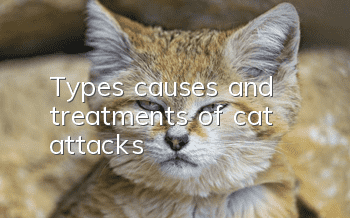Types, causes and treatments of cat attacks

Only those who have raised cats know that even very docile and friendly cats sometimes use sharp claws or teeth to attack humans or other creatures.
There are many reasons for attacks. If we handle these attacks incorrectly, it may produce worse results.
Today’s article will talk about: the various types, causes and treatment plans of cat attacks, so that you will no longer be distressed by your cat’s aggressive behavior.
There are 11 attack types in total, let’s analyze them one by one.
Male cats fighting
In a multi-cat household, a fight between two male cats is more likely than a fight between two female cats.
The root cause of male cat fights is: "testosterone", which is a steroid hormone. It has two major effects on male cat aggressive behavior: promoting aggression and improving defense.
Promoting aggression: In the field of cat brain neurology, testosterone is selectively taken into the parts of the brain responsible for aggression, which can promote aggression.
Improved defenses: This hormone triggers physical characteristics unique to male cats, such as thickened and firm skin. This physical feature acts as a "bulletproof vest" when attacked.
An effective solution to prevent male cats from fighting at home: castration surgery. After removing the testicles, testosterone secretion is reduced, which can effectively reduce aggression. It is understood that 80%-90% of castrated male cats will not actively engage in aggressive behavior.
Pain attack
Pain attack here refers to the cat’s instinctive reflex attack when humans or other creatures touch the painful or injured area of the cat.
Common pain areas in cats include the eyes, limb joints, abdomen or any part of the body with obvious trauma.
To prevent painful attacks, the most direct solution is to look for underlying diseases in cats.
We can observe whether the cat is in pain from some small details, such as:
Whether the conjunctiva is red
Whether eye secretions increase
Is the walking posture normal
Is there a lump in the abdomen
Whether the bladder is swollen
Is there any obvious trauma to the whole body
Vomiting and diarrhea
Mentally poor
Hide
If any abnormalities are found, consult a veterinarian immediately to avoid worsening of the condition and to prevent painful attacks.
Fear attack
Fear attack is when the cat feels a strong sense of fear and judges that it cannot escape and takes a counterattack.
While attacking, it will also display behaviors such as "exploding fur", "rapidly wagging its tail", and "making warning sounds".
In order to prevent cats from fearful and aggressive behavior, I think the important thing is not to put away items in the home that cause fear of cats, but the details of getting along with cats.
High-volume and sharp noises, sudden appearance of objects or animals, or inappropriate touching by people may make it frightened, so we should pay attention to it.
Maternal aggression
Maternal aggression refers to the attack mode displayed by pregnant or recently delivered female cats due to various reasons.
At this stage, it will be more vigilant due to its own special circumstances.
To avoid maternal aggression, try not to separate the kitten from the kitten, do not often catch the kitten, and do not suddenly appear next to the mother cat when she is resting.
Feed your cat more of its favorite food or soup to reduce its vigilance towards people. Also prepare a safe and quiet environment for it as much as possible, which can greatly increase its sense of security.
Turf attack
"Territory" refers to an area where a cat has left its scent and refuses to be invaded by other cats.
Territorial aggression refers to a cat’s attack on strange creatures that invade its territory. It often occurs between male cats, or when new and old cats meet for the first time.
The most common way for male cats to declare their territory is to "urinate".
If you want to avoid cat territory attacks, these two solutions can help you:
1. Neuter/castrate the cat.
2. When a new cat meets an old cat, do not meet directly. They need to be quarantined for 7-15 days. On the one hand, it is to prevent infectious diseases, and on the other hand, it is to help the two cats adapt to each other.
Competition attack
Competitive aggression refers to aggressive behavior between cats competing for limited resources. It is more common in multi-cat households or multi-pet households.
Limited resources include cat food, cat litter box, water, toys, height, basking position, owner's care, etc.
Solution: To prevent competition attacks, it is very important to evenly distribute cat supplies. Needless to say, prepare multiple cat litter boxes, multiple cat bowls, and water bowls. What's more important is to treat everyone equally and not be partial.
Reflection attack
Reflection attack is a bit convoluted. It is easier to understand using an analogy.
When a cat bites you and you give it a toy or snack it wants to eat, the cat will think that attack = reward, so it will have a conditioned reflex to attack you if it wants a reward, which is a reflex attack.
To avoid reflection attacks, it is importantThe key is not to associate aggression with reward, in other words your cat attacks you, ignores it or does something it hates, instead of giving it a treat.
Predatory attack
The so-called predatory attack refers to a conditioned reflex attack on prey, which is characterized by not causing anger.
Exhibit unique behaviors when hunting, such as approaching quietly, lowering posture, moving tail, jumping suddenly, etc.
The opportunity that triggers a cat’s instinctive behavior is called the “hunting source.”
To prevent predatory attacks from cats, eliminate irritating factors from your life. For example, when playing with your cat, it's best not to put your hands in a plastic bag and make a squeaking sound. Cats mistakenly thinking prey is in the bag can violently injure their owners' hands.
When playing, be sure to use cat toys and be careful not to use human hands or other parts.
Metastatic attack
Displaced aggression, also called deflected aggression, is simply a form of anger-based aggression. Any stress can trigger this event.
To avoid this kind of attack, we can deal with it from the root, perform stress management, and reduce the stress sources in the cat's life, thereby reducing stress and reducing anger.
Caress attack
Petting aggression refers to the behavior of a cat that stimulates its hunting instinct and scratches and bites its owner during a pleasant interaction with the cat.
In order to avoid caressing attacks, we need to find a limit on the caressing time, which should not exceed 20 minutes.
We also need to learn to observe the small movements of cats before caressing and attacking: pupils dilate (squinting when comfortable), tail wagging quickly, ears facing both sides (ears facing forward when comfortable).
Weak character attack
Weak character aggression refers to the aggressive behavior of cats during the socialization stage due to lack of familiarity with the surrounding environment, being bullied by other kittens, and being unable to grab milk or food.
A kitten with a weak personality is likely to have a withdrawn personality.
The socialization stage refers to a limited period of time that determines a kitten’s personality, usually 2 to 7 weeks after birth.
The solution can only be carried out in the socialization stage, allowing the kitten to passively accept a lot of stimulation, such as scratching its head, scratching its chin, touching its belly, playing with it with a cat teaser stick, etc.
If you are troubled by your cat’s aggressive behavior, I suggest you carefully record these three questions:
1. When did the aggressive behavior occur?
2. Where did the attack occur?
3. Opportunities for cat aggression
Understanding these issues will make it easier to determine the type of attack behavior and use the corresponding handling methods in the article.
One thing to remember: Do not use force, violence, punching or kicking the cat! This will only make the cat more alienated from you and even more aggressive!
- Will long-term consumption of cat food cause urinary tract stones?
- What are the major causes of abnormal cat poop? Here are some tips to easily deal with it!
- What should I do if my cat keeps meowing and it's annoying?
- Burmese cat training methods
- How to treat a biting cat? How to correct and train a biting cat?
- What issues should cat owners pay attention to after neutering a male cat?
- Do cats really like to drink flowing water? Is it necessary to buy an automatic water dispenser?
- Why does a cat sneeze continuously?
- Do Ragdoll cats shed a lot?
- The difference between soft and loose stools in cats



